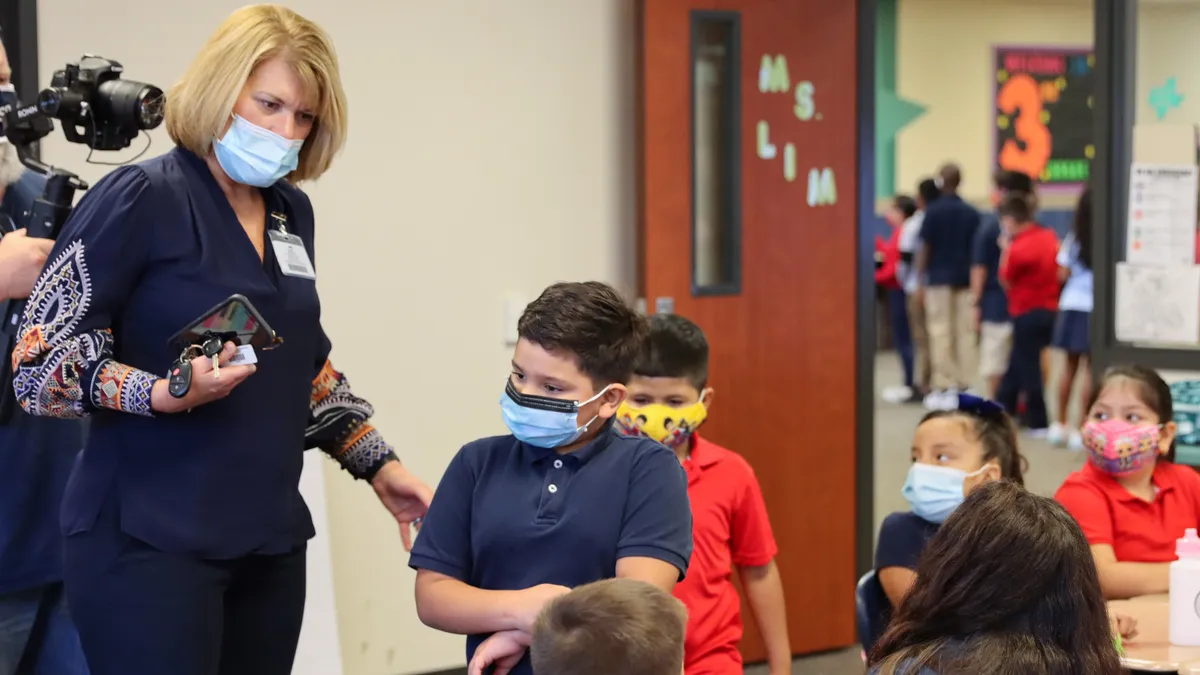Jonathan Hanover's brand new school, Roots Elementary, opened its doors for the first time six weeks ago, in northeast Denver, CO. Hanover is an unconventional school leader and his school reflects that.
He started out in finance and got into education doing pro-bono work for a young charter school in Chicago. After he was hired to work for a group in Colorado that supports charter schools interesting in expanding, he was inspired to start a school that mimicked what those schools got right and fixed what they didn’t. He took his first teaching job, a kindergarten position at a Denver charter, knowing he planned to open a school.
In 2013, he began laying the groundwork, meeting with community members and presenting the school. He and his team knocked on every door in the neighborhood and introduced themselves before the school opened. In an interview with Education Dive, Hanover explains his school's data-driven, yet progressive, model and how to make it work.
EDUCATION DIVE: Could you quickly lay out what Roots' model?
JONATHAN HANOVER: We've moved away from self-contained classrooms and as part of that, from contained grade levels as well. We do extensive diagnostic assessments to figure out exactly the kind of strengths and gaps for all our kids. Then our teachers put together personalized schedules for each of our scholars, to meet them where they are and to push them to where they need to be.
When you look at Roots physically, what you see is a large open space that's kind of flexible in nature, where you have different areas of it that are centers reserved for different types of self directed work. So a library, a writing center, an iPad center, a group work center, things like that.
What is the adult structure?
HANOVER: For 100 kids, we have six lead teachers. Four of them are content teachers. Two of them are coaches, basically teachers who aren’t responsible for delivering academic content but instead are responsible for building really deep relationships with kids and their families and then coaching scholars on what we call habits of success — their non-academic success factors that we all know are really important for success once they leave us but often get ignored in K-12.
There's a lot of talk about [character education] but it was important to me that we put our money where our mouth was and staffed it and set goals against it and measured against it just like we would academic goals.
What does a typical day look like?
HANOVER: What scholars do is they spend a good part of their day going from activity to activity, working on activities that have been designed by their content teachers, specifically for their level and what they need to work on. And then what our content teachers do is that they schedule kids for lessons, actually just using Google Calendar to kind of pull out of that space for targeted instruction.
One of the things we spent a lot of time on last year on was building a little web app that interacts with the Google API, so that our teachers can just use Google Calendar to just schedule our scholars for a lesson. And then there's a little app that we built on the front end for scholars that makes the information contained within a calendar invite understandable to a five year old who doesn’t have a concept of time yet and might not be able to read yet. It makes it all pictoral and image-based.
What sort of process do you guys have in place to go about selecting and designing these technologies?
HANOVER: Our general philosophy is that anything that’s out there we'll just take. The problem is that we're the only school that we're aware of that's doing personalized schedules in this way. So there was no technology to support it. Our director of operations and innovations is a former product manager at a tech company and what we were able to do was to find a really cheap developer, someone who was learning to be a coder at one of the coding schools here in Denver. I think we spent maybe $3,000 total on building the app.
So how well has the app been working?
HANOVER: It's worked well. We started using it with kids two weeks ago and then basically had a daily process where we looked at the technical systems and the human systems and at how we could improve them each day. I think this morning about 95% of kids are independently using that app to tell them where they need to go and then successfully getting there and getting to work.
It sounds like the adults in the building are going to have to use their time in a really different way. How does that work?
HANOVER: A lot of that was really intentional selection on the front end. We basically tried to scare off candidates by saying, "It's going to be super messy. We're going to rollout a system and then change it completely the next day," and kind of get people to self-screen. We also did a lot of exercises where we would tell a teacher they were going to come in and do a sample lesson. But [we wouldn't] tell them, "We’re going to give you some feedback about it and then you're going to run it back with a different group of kids five minutes later." [It helped us] see how well they can first accept feedback but then also just how they deal with like, "Ok, I wasn't planning on that but I'll just go in and I'll do what I can."
Would you like to see more education news like this in your inbox on a daily basis? Subscribe to our Education Dive email newsletter! You may also want to read Education Dive's look at a Texas KIPP principal's 3 MBA benefits for school leaders.




















